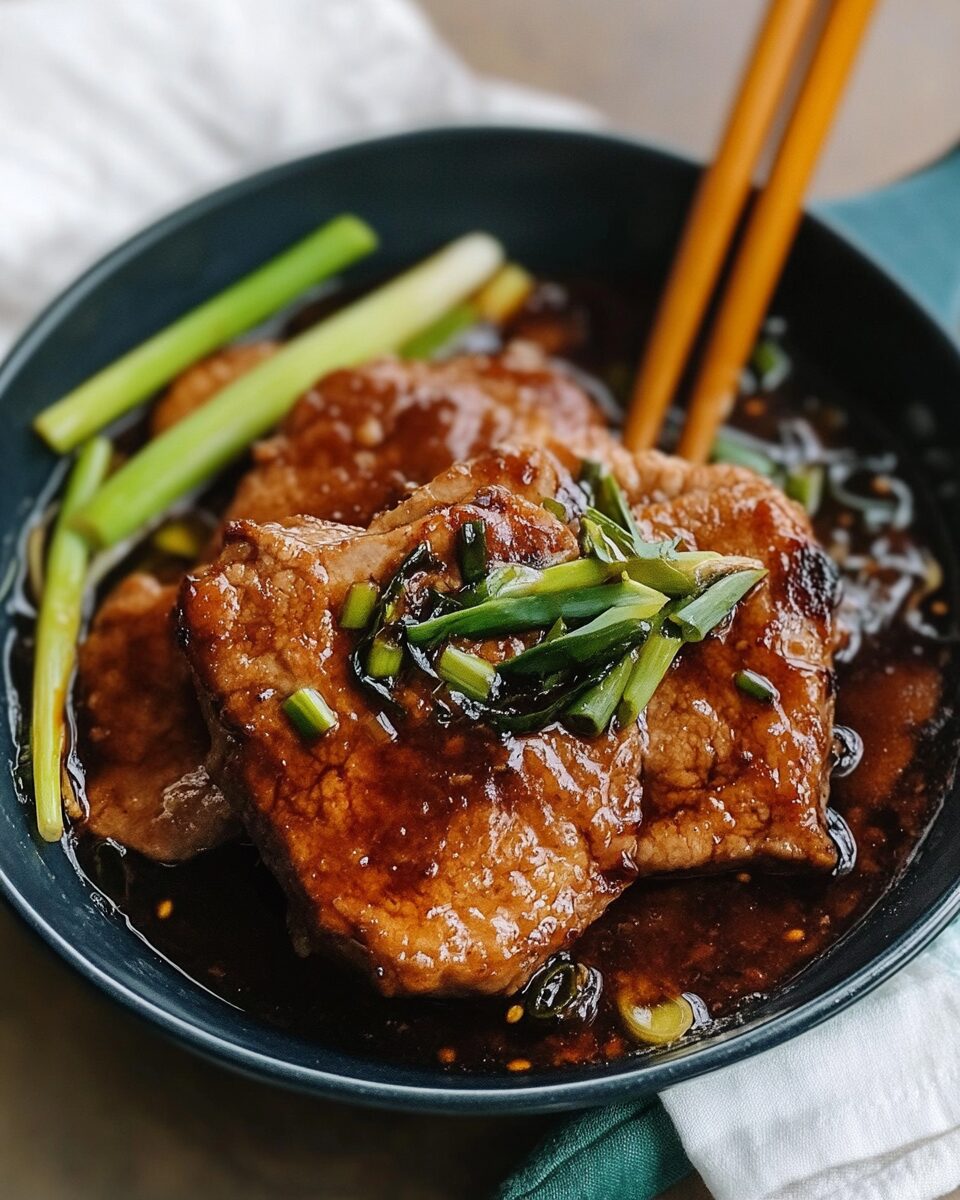These braised pork chops from Shanghai are a perfect example of how simple ingredients come together to create deep, layered flavors. The soy sauce base gives the sauce a rich, glossy sheen while the ginger and garlic add aromatic warmth. Slow braising makes the pork incredibly tender, allowing it to soak up every bit of the savory sauce.
Ideal for a comforting dinner, this dish pairs beautifully with steamed white rice or sautéed greens to balance the richness. Its hearty yet elegant presentation makes it suitable for family meals or impressing guests with authentic Chinese flavors in a home-cooked dish.
Full recipe:
Ingredients:
-
4 bone-in pork chops (about 1-inch thick)
-
2 tablespoons vegetable oil
-
3 tablespoons light soy sauce
-
1 tablespoon dark soy sauce
-
2 tablespoons Shaoxing wine (Chinese cooking wine)
-
1 tablespoon sugar
-
1-inch piece fresh ginger, sliced thin
-
2 cloves garlic, smashed
-
1 cup water or pork broth
-
2 scallions, cut into 2-inch lengths
-
White pepper, to taste
Directions:
-
Pat pork chops dry with paper towels and season lightly with white pepper.
-
Heat vegetable oil in a large skillet or wok over medium-high heat. Brown pork chops on both sides until golden, about 3 minutes per side. Remove and set aside.
-
In the same pan, add ginger and garlic, stir-frying until fragrant (about 30 seconds).
-
Add light soy sauce, dark soy sauce, Shaoxing wine, sugar, and water or broth. Stir to combine and bring to a gentle simmer.
-
Return the pork chops to the pan, spooning some sauce over them. Add scallions on top.
-
Reduce heat to low, cover, and braise the pork chops for 25-30 minutes, turning once halfway through, until tender and cooked through.
-
Remove the pork chops and let the sauce simmer uncovered for a few minutes to thicken if desired.
-
Serve the pork chops hot, spooning the braising sauce over them.
Prep Time: 10 minutes | Cooking Time: 40 minutes | Total Time: 50 minutes
Kcal: Approximately 400 kcal per serving | Servings: 4
Flavor Profile and Cooking Techniques
What sets Shanghai-style braised pork chops apart is the unique balance of flavors—umami from the soy sauces, sweetness from sugar, aromatic warmth from ginger, and a subtle depth from Shaoxing wine. The interplay of light and dark soy sauce is critical, as light soy sauce adds saltiness and umami, while dark soy sauce contributes a richer color and slight sweetness, resulting in a glossy, caramelized finish.
The key to this dish’s success lies in the braising process. Initially, the pork chops are seared at high heat to lock in juices and create a beautiful caramelized crust. This step is essential as it adds layers of flavor through the Maillard reaction, which is the chemical process responsible for browning. After searing, the chops are slowly cooked in the fragrant soy sauce mixture over low heat. This allows the flavors to penetrate the meat deeply and ensures the pork becomes tender without drying out.
Using a bone-in pork chop adds another dimension of flavor and helps keep the meat moist during the slow cooking. The bone marrow enriches the broth, giving the braising liquid a fuller, more robust taste.
Ingredient Insights and Variations
Each ingredient in this recipe plays a crucial role. Shaoxing wine, a traditional Chinese cooking wine, imparts a subtle nuttiness and complexity that’s hard to replicate with other types of wine or alcohol. If unavailable, dry sherry is a common substitute, but authentic Shaoxing wine is preferred for the most genuine flavor.
Fresh ginger and garlic provide an aromatic base that cuts through the richness of the pork and soy sauce. Ginger, in particular, is prized in Chinese cooking not only for its flavor but also for its digestive and warming properties, making it a perfect complement to pork.
Some cooks like to add a touch of star anise or cinnamon to the braising liquid for a slightly spiced variation. Others might incorporate sliced scallions or a splash of vinegar to add brightness and balance the richness.
For those wanting to customize the dish, varying the cut of pork or adjusting the sweetness level is possible. Some prefer leaner pork chops, while others enjoy the fattier cuts for more succulence. The sugar amount can be tweaked to suit personal taste—Shanghai cuisine generally leans toward a hint of sweetness that harmonizes with the savory ingredients.
Serving Suggestions and Pairings
Braised Shanghai pork chops are best served hot, spooning the glossy braising sauce over the meat to maximize flavor in every bite. Traditionally, this dish is accompanied by simple steamed white rice, which soaks up the rich sauce beautifully. The neutral rice balances the intensity of the pork, making the meal harmonious and satisfying.
To round out the meal, many enjoy pairing the pork chops with stir-fried greens such as bok choy, Chinese broccoli (gai lan), or spinach. These vegetables provide a fresh, crisp counterpoint to the richness of the pork. Pickled vegetables or a light cucumber salad can also add a refreshing contrast and cleanse the palate.
For a more substantial meal, consider serving alongside steamed buns or mantou, which can be dipped into the savory sauce. In restaurant settings, this dish may be part of a larger banquet featuring multiple small plates and soup, showcasing the diversity and richness of Shanghai-style cooking.
Health Considerations and Nutritional Aspects
While this dish is undeniably delicious, it is also important to be aware of its nutritional components. Pork chops provide a good source of protein and essential vitamins such as B12 and zinc, which are important for energy and immune function. However, the braising sauce contains soy sauce, which is relatively high in sodium, so moderation is key for those monitoring salt intake.
Using moderate amounts of oil and sugar ensures the dish remains flavorful without becoming overly heavy or unhealthy. For those seeking a lighter version, trimming excess fat from the pork or using leaner cuts can reduce calories and fat content.
Including plenty of vegetables with the dish adds fiber, vitamins, and minerals, helping to create a balanced meal. The ginger and garlic contribute not only to flavor but also offer health benefits, such as anti-inflammatory and antioxidant properties.
Cooking Tips and Common Mistakes to Avoid
Achieving perfect braised pork chops requires attention to detail. First, make sure to pat the pork chops dry before searing; this prevents steaming and helps create a crisp, caramelized crust. Don’t overcrowd the pan when browning the chops, as this can cause uneven cooking and prevent browning.
During the braising stage, maintain a gentle simmer rather than a rolling boil. Boiling aggressively can toughen the meat and reduce the sauce too quickly. Turning the pork chops halfway through the braise ensures even cooking and flavor distribution.
If the sauce is too thin at the end, removing the lid and simmering it uncovered will help reduce and thicken it. Conversely, if it becomes too salty or intense, adding a splash of water or broth can balance the flavors.
Finally, timing is crucial—overcooking can lead to dry, stringy meat, while undercooking leaves the pork tough. A slow, steady braise until the pork is just tender to the fork is ideal.
Why This Dish Is Perfect for Home Cooking
Braised Shanghai pork chops are an excellent dish for home cooks because they require simple ingredients and straightforward techniques but yield impressive results. The one-pan approach means less cleanup and a comforting aroma that fills the kitchen while cooking.
The dish also adapts well to batch cooking and leftovers. The flavors deepen overnight, making it a great option for meal prep or next-day enjoyment. It appeals to all ages and is a crowd-pleaser at family dinners or casual gatherings.
Most importantly, it offers a taste of authentic Chinese home cooking without needing complicated or hard-to-find ingredients, making it accessible and rewarding for cooks of any skill level.
Conclusion
Braised Shanghai pork chops capture the heart of traditional Shanghai cuisine—a balance of savory, sweet, and aromatic flavors combined with tender, juicy pork that melts in your mouth. This dish exemplifies the art of braising, turning simple pork chops into a luxurious, comforting meal.
Whether you’re new to Chinese cooking or a seasoned foodie, making these pork chops at home is a delicious way to explore authentic flavors and techniques. Paired with steamed rice and fresh vegetables, it’s a meal that warms the soul and satisfies every craving for rich, comforting food.
With its elegant simplicity, deep flavors, and adaptable nature, this recipe deserves a place in your weekly dinner rotation. Once you try it, the tender, soy-braised pork chops of Shanghai will surely become a favorite for years to come.






